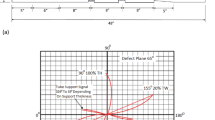Abstract
Premature failure of welded steam piping in electric utility service led to the need for a life prediction tool. A software was developed that performs a global stress analysis and remaining service life prediction of these high temperature piping systems. Using the global stress results the local stresses at the seam weld location are computed for each pipe. These local stresses at the seam weld are used with a creep damage model to determine the remaining service life of each pipe. The scale factor for each stress component in the pipe is obtained from a library of data tables and curve fit equations that model the effect of several piping and weld parameters on the local seam weld stresses. The parameters used are the cylinder peak angle, the weld bevel angle, the axial to hoop stress ratio, the weld material to base material creep rate ratio, and the heat affected zone (HAZ) to base material creep rate ratio. Each of these parameters was varied over a range of typical values in an axial seam welded pipe analysis case study. The results of the case study were used to create a subroutine that computes the local seam weld stresses. The high temperature creep analysis was done using a finite element analysis (FEA) mesh of the pipe cross section. The FEA mesh models the shape of the pipe and the weld, the applied loads and temperatures, and the weld and base material values. The analysis captures the time varying creep behavior of the pipe. For the weld material 64 parameter cases were analyzed, and for the HAZ 60 parameter cases were analyzed. The FEA case study results of the creep analysis were tabulated or curve-fit for use in the stress scale factor calculation. The analyses were done using the Abaqus FEA software. The scale factors are calculated from the tables and curve fit equations by a Fortran subroutine. The scale factor subroutine is used in the life assessment calculations to determine the remaining service life of the pipe. Previous case study results for pipe girth welds were available and were also included in the Fortran subroutine. Using that existing information, the subroutine can also compute local scaled stresses in a pipe near the girth weld.
Similar content being viewed by others
References
Lundin, G. Zhou, and M. Prager, “Failure Modes of Welded Steam Piping”, ASME PVP — vol. 380, pp. 331–344, 1998.
Lundin and M. Prager, “A New Approach to Investigation Into Type IV Cracking Susceptibility, ASME PVP — vol. 380, pp. 345–353, 1998.
M. Prager, “Development of the MPC Project Omega Method for Life Assessment in the Creep Range”, ASME PVP — vol. 288, pp. 401–421, 1994.
M. Prager, “The Omega Method — An Effective Method for Life and Damage Prediction in Creep Tests and Service”, Oikawa (eds.), Strength of Materials, Japan Institute of Metals, pp. 571–574, 1994.
Author information
Authors and Affiliations
Rights and permissions
About this article
Cite this article
Thorwald, G.V., Anderson, T.L. & Prager, M. Effect of Materials and Geometrical Variables on Creep Behaviour of Welds. Weld World 47, 15–31 (2003). https://doi.org/10.1007/BF03266386
Published:
Issue Date:
DOI: https://doi.org/10.1007/BF03266386




